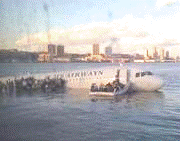Bird Strike Committee Proceedings

Bird Strike Committee-USA/Canada Joint Annual Meeting: 10th (2008)
Date of this Version
8-2008
Document Type
Article
Abstract
From 1997 to 2007, 821 bat strikes were reported to the United States Air Force (USAF). Many samples were identified by macroscopic and/or microscopic comparisons with bat specimens housed in the Smithsonian’s National Museum of Natural History, and in recent years by using molecular techniques. We received bat strike reports from 20 countries and 40 of the United States during this time frame. Forty-six percent of the strikes were identified to order; 5% were identified to family or genus; and 49% were identified to the species level. Fiftyfive of the 101 bat strikes submitted for DNA analysis since 2006 resulted in species-level identifications. Twenty-five species of bat have been recorded striking USAF planes world-wide. The most commonly identified bat involved in USAF strike impacts is the Brazilian free-tailed bat (Tadarida brasiliensis; n=173), followed by the red bat (Lasiurus borealis; n=83). Bat strikes peaked during the spring and fall with more than 57% taking place between August and October; 82% of the strikes that recorded a mishap time occurred between 2100 and 0900; and more than 12% of the bat strikes were reported at or above 1000 feet. Although less than 1% of the bat strike reports indicated damage to USAF aircraft, cumulative damages for 1997-2007 totaled over $825,000.00 and more than half of this sum is attributed to five bat strikes. Only five of the ten most damaging bat strikes were identified to the species level because we did not receive samples, or the evidence received was insufficient for identification. Improving the identification of bat species involved in aircraft strikes will increase our knowledge of bat movement, life history, and behavior, and help improve flying safety by predicting times, areas, and altitudes of increased bat movement and activity.


Comments
Abstract of paper presented at Bird Strike Committee USA/Canada Meeting, Lake Mary and Sanford, Florida, August 18–21, 2008.